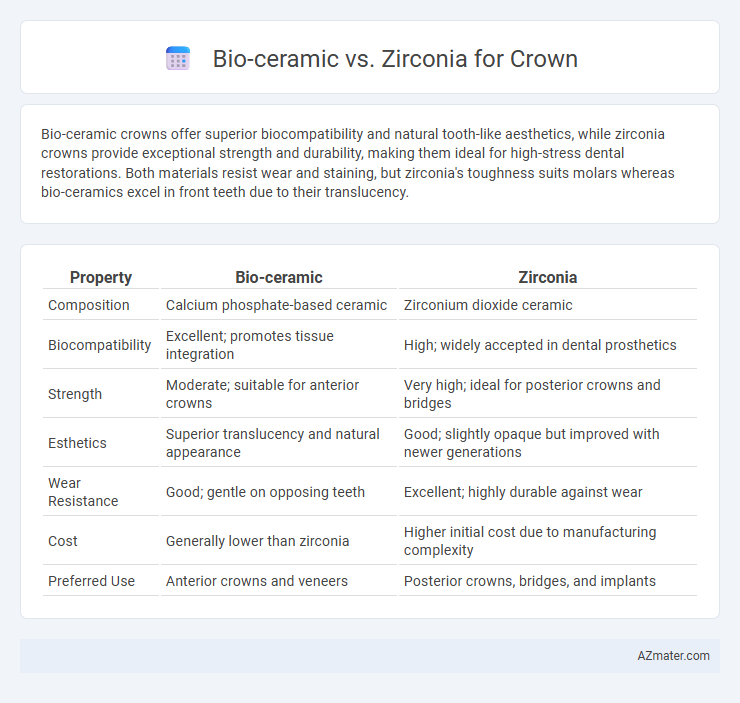Bio-ceramic crowns offer superior biocompatibility and natural tooth-like aesthetics, while zirconia crowns provide exceptional strength and durability, making them ideal for high-stress dental restorations. Both materials resist wear and staining, but zirconia's toughness suits molars whereas bio-ceramics excel in front teeth due to their translucency.
Table of Comparison
| Property | Bio-ceramic | Zirconia |
|---|---|---|
| Composition | Calcium phosphate-based ceramic | Zirconium dioxide ceramic |
| Biocompatibility | Excellent; promotes tissue integration | High; widely accepted in dental prosthetics |
| Strength | Moderate; suitable for anterior crowns | Very high; ideal for posterior crowns and bridges |
| Esthetics | Superior translucency and natural appearance | Good; slightly opaque but improved with newer generations |
| Wear Resistance | Good; gentle on opposing teeth | Excellent; highly durable against wear |
| Cost | Generally lower than zirconia | Higher initial cost due to manufacturing complexity |
| Preferred Use | Anterior crowns and veneers | Posterior crowns, bridges, and implants |
Introduction to Dental Crown Materials
Dental crown materials like bio-ceramics and zirconia offer distinct advantages based on composition and durability. Bio-ceramics are prized for biocompatibility and natural tooth-like aesthetics, while zirconia crowns provide superior strength and resistance to fracture. Choosing between these materials depends on clinical needs, aesthetic preferences, and long-term performance requirements.
What are Bio-ceramic Crowns?
Bio-ceramic crowns are dental restorations made from advanced ceramic materials composed primarily of bio-compatible substances like alumina and zirconia oxide, designed to mimic natural tooth structure. These crowns offer excellent biocompatibility, strength, and resistance to wear, making them suitable for patients with metal allergies or those seeking metal-free dental solutions. Their ability to integrate well with surrounding tissues and provide superior aesthetics distinguishes bio-ceramic crowns from traditional zirconia crowns.
Understanding Zirconia Crowns
Zirconia crowns are renowned for their exceptional strength and durability, making them one of the most preferred materials for dental restorations. Unlike bio-ceramic crowns, zirconia crowns offer superior resistance to chipping and fracture, ensuring long-lasting performance in both anterior and posterior teeth. Their biocompatibility and natural tooth-like appearance contribute to improved patient satisfaction in restorative dentistry.
Strength and Durability: Bio-ceramic vs Zirconia
Zirconia crowns exhibit superior strength and durability, with a flexural strength of approximately 900-1200 MPa, making them highly resistant to fractures and ideal for molars under heavy occlusal forces. Bio-ceramic crowns, while biocompatible and aesthetically pleasing, generally offer lower strength, around 300-400 MPa, which limits their use in high-stress areas. The inherent toughness and fracture resistance of zirconia ensure longer-lasting restorations compared to bio-ceramic materials.
Aesthetics and Natural Appearance Comparison
Bio-ceramic crowns offer superior translucency and color matching, closely mimicking the natural enamel's light-reflecting properties for enhanced aesthetics. Zirconia crowns, while exceptionally durable, tend to be more opaque, which can result in a less lifelike appearance under certain lighting conditions. Both materials provide biocompatibility, but bio-ceramics are often preferred for anterior restorations due to their ability to achieve a more natural and seamless integration with surrounding teeth.
Biocompatibility and Allergy Considerations
Bio-ceramic crowns offer superior biocompatibility with minimal risk of allergic reactions due to their inert and non-metallic composition, making them ideal for patients with metal sensitivities. Zirconia crowns are highly durable and biocompatible but may occasionally cause allergic responses in rare cases due to trace metal elements used during manufacturing. Both materials provide excellent tissue compatibility, but bio-ceramics are preferred for patients with heightened allergy concerns or compromised immune systems.
Longevity and Maintenance Requirements
Zirconia crowns exhibit exceptional longevity due to their high fracture toughness and resistance to wear, often lasting over 10-15 years with minimal maintenance. Bio-ceramic crowns, while biocompatible and aesthetically pleasing, generally have lower strength and may require more frequent replacement or repair. Maintenance for zirconia crowns typically involves routine dental hygiene, whereas bio-ceramic crowns may demand careful monitoring to prevent chipping or surface degradation over time.
Cost Differences Between Bio-ceramic and Zirconia
Bio-ceramic crowns typically cost less than zirconia crowns due to lower material and production expenses. Zirconia crowns demand advanced manufacturing processes and higher-quality raw materials, resulting in increased prices ranging from $1,000 to $2,500 per crown. Patients seeking cost-effective dental restoration often prefer bio-ceramic options, which usually fall between $800 and $1,500 per crown while maintaining durability and biocompatibility.
Clinical Indications: When to Choose Each Material
Bio-ceramic crowns are ideal for patients with metal allergies and those requiring exceptional biocompatibility, often used in anterior restorations due to their superior aesthetics and translucency. Zirconia crowns provide high strength and fracture resistance, making them suitable for posterior teeth and areas with high occlusal forces. Clinical decisions depend on balancing aesthetic demands, durability requirements, and patient-specific factors like sensitivity or allergic reactions.
Patient Satisfaction and Case Studies
Patient satisfaction with bio-ceramic crowns often stems from their superior biocompatibility and natural tooth-like appearance, which enhances comfort and aesthetics. Case studies highlight zirconia crowns' exceptional strength and durability, leading to fewer complications and longer-lasting restorations in high-stress areas. Comparative research indicates bio-ceramic crowns excel in soft tissue integration, while zirconia crowns provide higher fracture resistance, influencing personalized treatment decisions based on patient-specific needs.

Infographic: Bio-ceramic vs Zirconia for Crown
 azmater.com
azmater.com